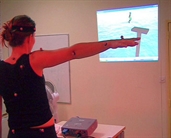

Franck Multon
Professor University Rennes 2 - Inria
2008

Dynamic motion adaptation for 3D acrobatic humanoids. F. Multon, L. Hoyet, T. Komura and R. Kulpa, IEEE Humanoids'2007 November 2007
Low-cost dynamics is a key issue in planning complex motions. This paper aims at proposing a fast algorithm in order to simulate aerial motions for humanoids while using motion capture data. As the real subject has obviously different anthropometric parameters than the synthetic robot, directly applying motion capture data leads to a non-respect of physical laws. As a consequence, the humanoid can land in a bad configuration. During aerial phase, the acceleration of the center of mass may be different from gravity and the angular momentum may change incorrectly. This so-called retargetting problem is generally addressed in computer animation by solving kinematic constraints. In this paper, we propose a dynamic filter that is able to rapidly adapt motion in order to preserve its physical correctness. If the original motion is changed by a user or just replayed on a different skeleton, the filter is about to correct the postures at each time step in less than 2ms in a common computer. It's consequently possible to change an arm motion during the aerial phase and to immediately check its effect on the global rotation of the humanoid.
Low-cost dynamics is a key issue in planning complex motions. This paper aims at proposing a fast algorithm in order to simulate aerial motions for humanoids while using motion capture data. As the real subject has obviously different anthropometric parameters than the synthetic robot, directly applying motion capture data leads to a non-respect of physical laws. As a consequence, the humanoid can land in a bad configuration. During aerial phase, the acceleration of the center of mass may be different from gravity and the angular momentum may change incorrectly. This so-called retargetting problem is generally addressed in computer animation by solving kinematic constraints. In this paper, we propose a dynamic filter that is able to rapidly adapt motion in order to preserve its physical correctness. If the original motion is changed by a user or just replayed on a different skeleton, the filter is about to correct the postures at each time step in less than 2ms in a common computer. It's consequently possible to change an arm motion during the aerial phase and to immediately check its effect on the global rotation of the humanoid.

Interactive control of physically-valid aerial motion: application to VR training system for gymnasts. F. Multon, L. Hoyet, T. Komura and R. Kulpa, ACM VRST'2007 November 2007, pp77-80
This paper aims at proposing a new method to animate aerial motions in interactive environments while taking dynamics into account. Classical approaches are based on spacetime constraints and require a complete knowledge of the motion. However, in Virtual Reality, the user's actions are unpredictable so that such techniques cannot be used. In this paper, we deal with the simulation of gymnastic aerial motions in virtual reality. A user can directly interact with the virtual gymnast thanks to a real-time motion capture system. The user's arm motions are blended to the original aerial motions in order to verify their consequences on the virtual gymnast's performance. Hence, a user can select an initial motion, an initial velocity vector, an initial angular momentum, and a virtual character. Each of these choices has a direct influence on mechanical values such as the linear and angular momentum. We thus have developed an original method to adapt the character's poses at each time step in order to make these values compatible with mechanical laws: the angular momentum is constant during the aerial phase and the linear one is determined at take-off. Our method enables to animate up to 16 characters at 30hz on a common PC. To sum-up, our method enables to solve kinematic constraints, to retarget motion and to correct it to satisfy mechanical laws. The virtual gymnast application described in this paper is very promising to help sportsmen getting some ideas which postures are better during the aerial phase for better performance.
This paper aims at proposing a new method to animate aerial motions in interactive environments while taking dynamics into account. Classical approaches are based on spacetime constraints and require a complete knowledge of the motion. However, in Virtual Reality, the user's actions are unpredictable so that such techniques cannot be used. In this paper, we deal with the simulation of gymnastic aerial motions in virtual reality. A user can directly interact with the virtual gymnast thanks to a real-time motion capture system. The user's arm motions are blended to the original aerial motions in order to verify their consequences on the virtual gymnast's performance. Hence, a user can select an initial motion, an initial velocity vector, an initial angular momentum, and a virtual character. Each of these choices has a direct influence on mechanical values such as the linear and angular momentum. We thus have developed an original method to adapt the character's poses at each time step in order to make these values compatible with mechanical laws: the angular momentum is constant during the aerial phase and the linear one is determined at take-off. Our method enables to animate up to 16 characters at 30hz on a common PC. To sum-up, our method enables to solve kinematic constraints, to retarget motion and to correct it to satisfy mechanical laws. The virtual gymnast application described in this paper is very promising to help sportsmen getting some ideas which postures are better during the aerial phase for better performance.


